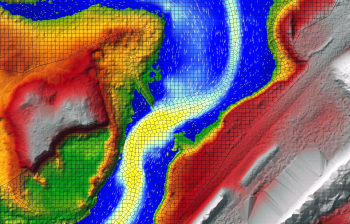Engineering Analysis: Difference between revisions
(Created page with "<!-- Default code to remove table of contents and add line break at top of page --> __NOTOC__ <!-- Add Category to drive breadcrumb menus --> Category: Engineering ---- <!-- Introductory paragraph or topic page summary --> Engineers use many methods to analyze existing or proposed dams. This includes hand calculations, empirical methods, and computational methods or software. The complexity and data/resource requirements of these various analytic procedures varies...") |
No edit summary |
||
| (2 intermediate revisions by the same user not shown) | |||
| Line 4: | Line 4: | ||
[[Category: Engineering]] | [[Category: Engineering]] | ||
---- | ---- | ||
{{Picture | |||
|image= | |||
<!-- Add image file name (ex.image.jpg) --> | |||
2dmodel.png | |||
|link= | |||
<!--https://www.usgs.gov/media/images/two-dimensional-hydraulic-model--> | |||
|caption= | |||
<!-- Add picture caption --> | |||
A two-dimensional hydraulic model. | |||
(Image Source: [https://www.usgs.gov/media/images/two-dimensional-hydraulic-model USGS, 2021]) | |||
}} | |||
<!-- Introductory paragraph or topic page summary --> | <!-- Introductory paragraph or topic page summary --> | ||
==Types of Analyses== | |||
Engineers use many methods to analyze existing or proposed dams. This includes hand calculations, empirical methods, and computational methods or software. The complexity and data/resource requirements of these various analytic procedures varies greatly depending on the application and desired output. The following is a list of [[engineering]] analyses that are commonly used in design of [[New Dams|new dams]] or the assessment of existing dams: | Engineers use many methods to analyze existing or proposed dams. This includes hand calculations, empirical methods, and computational methods or software. The complexity and data/resource requirements of these various analytic procedures varies greatly depending on the application and desired output. The following is a list of [[engineering]] analyses that are commonly used in design of [[New Dams|new dams]] or the assessment of existing dams: | ||
* [[Hydraulics | Hydraulic Analysis]] | * [[Hydraulics | Hydraulic Analysis]] | ||
| Line 12: | Line 25: | ||
* [[Slope Stability | Slope Stability Analysis]] | * [[Slope Stability | Slope Stability Analysis]] | ||
* [[Global Stability of a Dam | Structural Analysis]] | * [[Global Stability of a Dam | Structural Analysis]] | ||
* [[Seismic | Seismic Analysis]] | |||
* [[Risk Analysis]] | * [[Risk Analysis]] | ||
* [[Consequence Analysis]] | |||
==Modeling Communication== | |||
A critical aspect of any engineering analysis is communication. There are a variety of approaches and methodologies for most types of analysis, and it is important to owners, consultants, and regulators that clear communication is integrated in the process. Guidance and recommendations regarding both pre- and post-modeling communication are provided on this page: [[Modeling Communication]]. | |||
Latest revision as of 19:36, 27 August 2024

|
| A two-dimensional hydraulic model.
(Image Source: USGS, 2021) |
Types of Analyses
Engineers use many methods to analyze existing or proposed dams. This includes hand calculations, empirical methods, and computational methods or software. The complexity and data/resource requirements of these various analytic procedures varies greatly depending on the application and desired output. The following is a list of engineering analyses that are commonly used in design of new dams or the assessment of existing dams:
- Hydraulic Analysis
- Hydrologic Analysis
- Seepage Analysis
- Slope Stability Analysis
- Structural Analysis
- Seismic Analysis
- Risk Analysis
- Consequence Analysis
Modeling Communication
A critical aspect of any engineering analysis is communication. There are a variety of approaches and methodologies for most types of analysis, and it is important to owners, consultants, and regulators that clear communication is integrated in the process. Guidance and recommendations regarding both pre- and post-modeling communication are provided on this page: Modeling Communication.
Citations:
Revision ID: 8034
Revision Date: 08/27/2024
